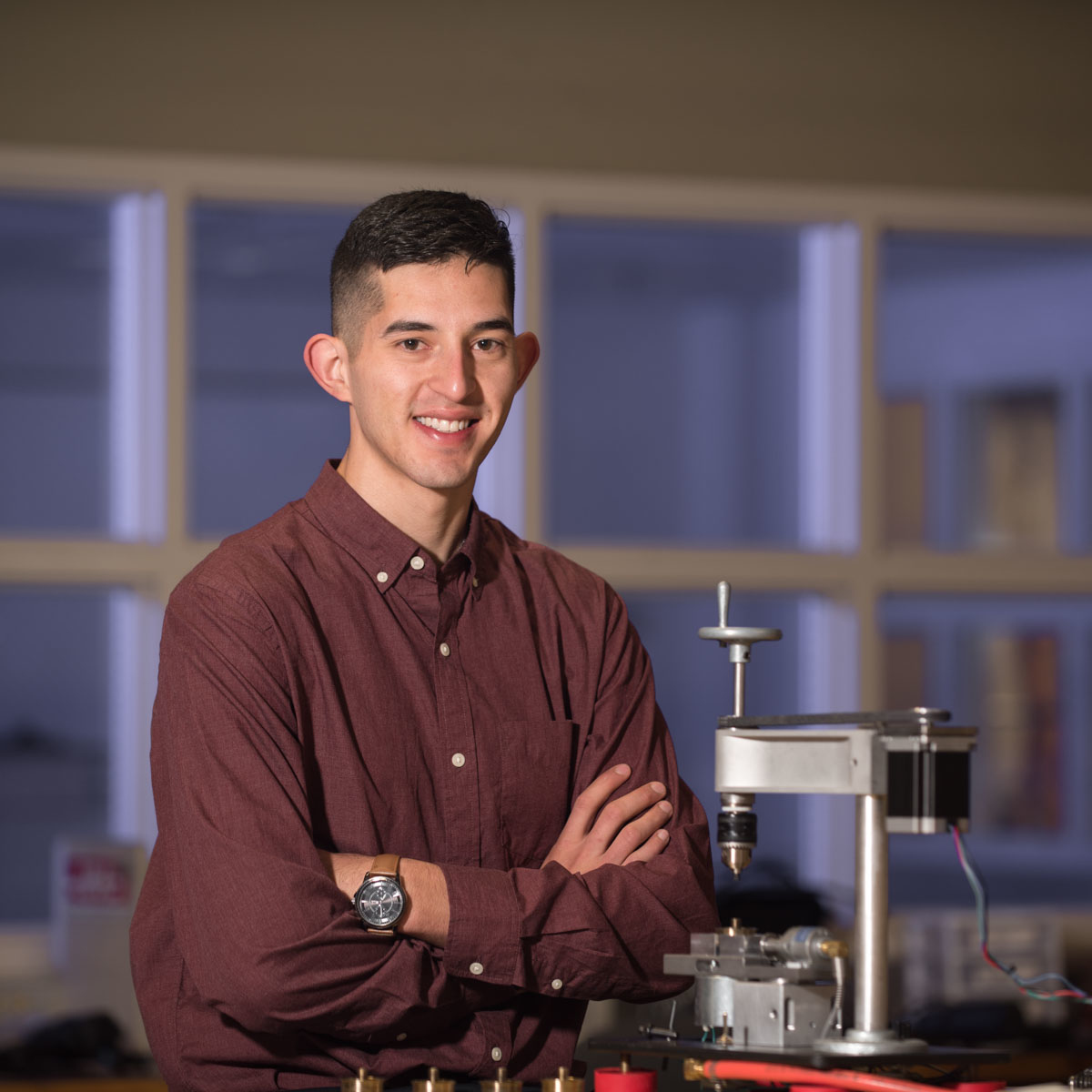Farm Laborer to Intel Engineer
Farm Laborer to Intel Engineer: Mechanical Engineering grad Selso Gallegos credits Hispanic community for empathetic perspective and work ethic.
Every summer from age 11 to 18, Selso Gallegos worked as a farm laborer in Idaho’s Treasure Valley. He picked cherries and apples, detasseled corn and weeded onions alongside his family.
Time after time, he experienced the inefficiencies of equipment and harvesting practices that affected the owners’ bottom line and the laborers’ ability to make a living wage. Tractor-trailers full of picked produce would stall or move too slowly. Other times, trailers would tip over, spilling entire crates of fruits or vegetables.
“Everything we were doing, I always saw better ways of doing it,” said Gallegos, a Parma native named a College of Engineering Outstanding Senior for spring 2017.
His first-hand experience, along with a passion for math and science, sparked Gallegos’ interest in process improvements within the manufacturing industry. This May, he graduates with a bachelor’s degree in mechanical engineering from the College of Engineering. In June, he starts a job at Intel outside Phoenix. Gallegos will improve the way Intel’s semiconductor chips are made, ensuring the manufacturing process doesn’t introduce defects to the chips.
New Direction
As a high school student, Gallegos assumed he would pursue a two-year technical degree for auto mechanics, as many of his peers did. Then he attended the Vandal Challenge leadership conference in 2012 and 2013, sponsored by the university’s Organización de Estudiantes Latino Americanos, which showed him what an engineering degree could offer.
At U of I, Gallegos has gotten hands-on experience in his field. This spring, he completed a mechanism for his senior capstone project to improve the method for burnishing turrets for high-precision riflescopes made by Orofino-based company Nightforce Optics. Gallegos and his team designed and built a prototype to automate the process.
Currently, Nightforce employees use a hand drill to burnish turrets. While the quality is excellent, Gallegos said, the process is inefficient — both ergonomically and in meeting demand needs.
“We presented the prototype and capability of the machine to their engineers there, which was cool,” Gallegos said. “They liked it a lot and were pretty excited about having something they’ll be able to use.”
The future engineer finds automation desirable because he knows what it’s like to be a laborer.
“Since I worked in farm labor, I kind of understand how it feels to be at the bottom and not be valued, even though the work you’re doing is some of the most important and the end product is based off of you,” Gallegos said.
He sees automation as offering more opportunity to laborers — maybe they’ll oversee the production process, he said, or grow into other positions.
During his time at U of I, Gallegos also became a STEM tutor for students like himself who are supported by U of I’s College Assistance Migrant Program (CAMP). He also became involved in the Society of Hispanic Professional Engineers.
Members of the organization hold fundraisers so they can attend regional and national conferences. They also seek out professional development and networking opportunities to increase the likelihood of Hispanic students securing internships and industry jobs, and they perform outreach by visiting high schools to promote engineering in the Hispanic community.
“There weren’t many people targeting the Hispanic community when I was growing up,” Gallegos said. “I felt a lot of times that engineering was out of reach, but I want to let them know that it’s not.”
Global Perspective
Gallegos also has a drive to understand other ways of life around the world.
When he was 4 years old, he and his seven siblings returned to his parents’ hometown of Michocoán, Mexico for 18 months to claim his family’s land when his grandfather died. While he said he feels a responsibility to support the Hispanic community, he also wants to help those living in poverty around the globe.
During his 2016-17 winter break, Gallegos went on an Alternative Service Break to Esmeraldas, Ecuador. He worked on several projects to improve the quality of life in impoverished communities.
“Seeing another part of the world and the day-to-day life of other people made me realize that people are people everywhere you go,” Gallegos said. “People in Ecuador are exactly like the people in Idaho.
“You’d think that just because they’re on the other side of the world, they’re going to be different because of their circumstances. But if you sit down and talk to them, their ambitions are the same.”
The ambitions, Gallegos said, are to create better lives for themselves and their family — something he saw his parents do in leaving Mexico and pushing their children toward higher education. It’s also what he hopes to do in his future career, improving the manufacturing process for a company’s bottom line, sure, but also for the laborers involved.
Article by Kate Keenan, College of Art and Architecture.








